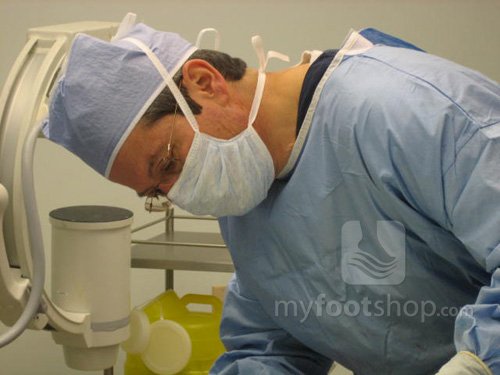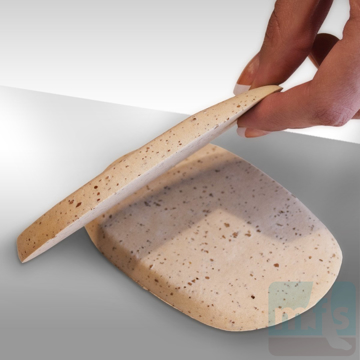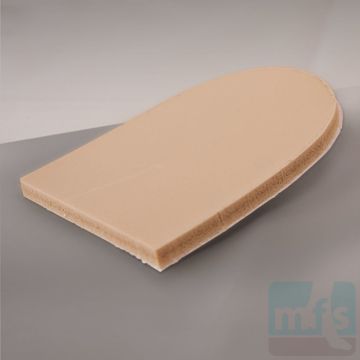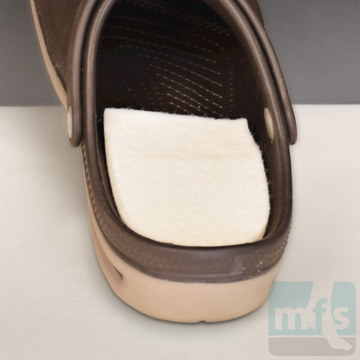This post is part of a seven section blog on the diagnosis and treatment of plantar fasciitis. This post discusses complications of endoscopic plantar fasciotomy.
Surgical complications of endoscopic plantar fasciotomy

Back in the early 1980s when I was a new doc in practice, I was puzzled by the post-op course of traditional 'old school' heel spur surgeries (open with resection of the spur.) Some patients did really quite well. Once their wound healed they went on to get back to full activities within a matter of two months. But then there were a few patients who went on to have pain that lasted upwards of a year. The pain that the later group of patients experienced was unique in that the pain was not specific to the heel and the site of surgery. The pain was in the top of the arch and the outside of the foot. These patients experienced minimal swelling but had pain when they first tried to stand. This pain increased with the duration of time spent on the feet. All of these patients went on to eventually heal but it was a long course of healing. Knowing this, recommending a heel spur surgery was not something that you'd recommend very often. But you had to wonder why some people did so well while others took so long to heal.
In the mid-1980s, I was fortunate to train in a new technique called endoscopic plantar fasciotomy (EPF.) The EPF procedure was really quite an amazing advance compared to what I had learned in residency training. The old heel spur resection was an open and very traumatic procedure. The EPF, on the other hand, was performed through a 1cm incision. Patients were able to walk on the surgery the same day and were usually back in a regular street shoe and just a Band-Aid within 3 days of surgery. Amazing stuff. And patients just came out of the woodwork to have this new procedure done. The volume of patients that I saw enabled me to be witness to trends. The most striking trend was in about 10% of patients who had post-op arch and foot pain. These patients did very well with their surgery. They followed the normal post-op course and were back in regular shoes, very pleased with their choice to have the surgery done. As the incisions healed, patients would assume that the change affected by the surgery was also healed. So at 4-6 weeks following their surgery they would resume their normal activities only to develop pain in the top and outside of the foot.
When a patient consents to a surgery, they assume their doctor is fully aware of the possible risks and complications of the surgery. And to a great extent, that's true in that the doctor has done a number of these surgeries and been able to witness the post-op course of the patients. Although the EPF was a simple improvement of what had been performed for years, I now had a new problem that I couldn't explain to my patients. I remember treating a male nurse who underwent his first EPF and was so pleased that he wanted to complete the surgery on his other foot. So six weeks out on the first procedure I performed an EPF on his other foot. And then things went bad. As he returned to work and his normal activity level he developed pain in the arch and outside column of the foot (the foot can be split into a medial and lateral column). He was obviously upset that this complication wasn't explained prior to surgery. He ultimately ended up seeing another doctor for a second opinion. The second opinion doctor obtained a bone scan that lit up in the midfoot. Although a bone scan is nonspecific and cannot determine the reason for inflammation, it is a great test to find areas of inflammation. What the bone scan suggested was that this patient had acute inflammation suggestive of a stress fracture.
Why had he developed a stress fracture? That got all of us early adopters of EPF surgery on the phone to share cases and discuss what was happening and why 10% of all of our cases were experiencing this same complication. What we found was a similar pattern in every practice. What we were seeing in EPF surgery was a complication that had been present all along. Remember the subset of patients who underwent traditional heel spur surgery and took a year to heal? That same complication was still present with the new advanced EPF procedure but now much more apparent due to the minimally invasive nature of the EPF procedure.
What is lateral column syndrome?
What we were seeing wasn't really a problem specifically due to the surgery. Interestingly, what we were seeing was a complication that was indirectly related to the surgery. This complication, what we now call lateral column syndrome (LCS), was a complication due to the biomechanical change that the surgery had caused. The surgery, whether performed with the older open method or with the new EPF method changed the biomechanical function of the foot. So as a patient started to use the foot the structural interface of the joints was different. And that change created vague pain in the bones and the joints of the foot.
Bones and joints can accommodate change but it takes time, usually in the range of weeks to months. What we were seeing was a response of the bones and joints of the midfoot and lateral column of the foot to change. And change it did not like. Some patients described stiffness in the arch of the foot following EPF surgery. But for this subset of 10% of our patients, the pain went way beyond stiffness. It was pain that mimicked a fracture. The pain improved with rest but hurt with weight-bearing and increased with the duration of time spent on the foot. These symptoms are exactly what a person experiences with a stress fracture. So we began to treat these cases as stress fractures using a walking cast and rest. And most importantly, we reassured our patients that this was a new trend that we had identified with the use of our new, less traumatic approach.
There's an important lesson to be learned here. As patients, we tend to think in a linear manner. We expect this symptom or limitation in the first-week post-op, this or that the second week and so on. But when you're doing well and a new symptom occurs it'll throw that linear thinking for a loop. That's why it's so important to prep your EPF patients pre-op and through the immediate post-op period to understand the symptoms of lateral column syndrome. Although I have performed a lot of EPF surgeries my patients are by no means immune to LCS. But when those patients fully understand the symptoms of LCS they're back in the office saying, "are the symptoms that you had told me about. I'm glad you warned me about this." These patients don't get upset. They understand what lateral column syndrome is and why it may have occurred. And we work together to get them better.
Additional topics in the blog series include:
Plantar fasciitis | History
Plantar fasciitis | Causes and contributing factors
Plantar fasciitis | Differential diagnosis of heel pain
Plantar fasciitis | Conservative methods of care
Plantar fasciitis | Surgical treatment
Plantar fasciitis | Additional treatment methods
Jeff
Medical Advisor
Myfootshop.com
Updated 4/23/2021
















One of the challenges of ESWT is cost. It's coverage with insurance is spotty at best and often results in a cash out-of-pocket solution.
In terms of side effects, they are limited. There's a few articles in the literature that discuss stress fractures as a result of ESWT, but those represent a very small number of the overall cases performed. For the most part, ESWT is safe.
Jeff
Jeffrey A. Oster, DPM
Medical Director
Myfootshop.com
The cut fascia does heal during the first 6 months following an endoscopic plantar fasciotomy. Most doctors will release only the medial band of the fascia leaving the central and lateral bands intact. That means that the majority of the plantar fascia is still anchored, just not the medial band. The fascia heals in a lengthened position so that he tugging on the medial tubercle of the heel, called enthesiopathy, is corrected.
Jeff
Jeffrey A. Oster, DPM
Medical Director
Myfootshop.com